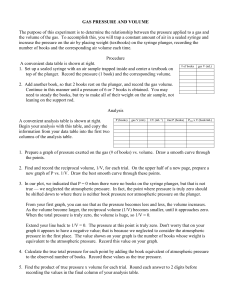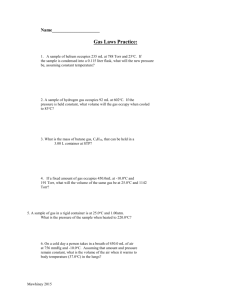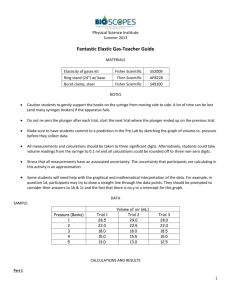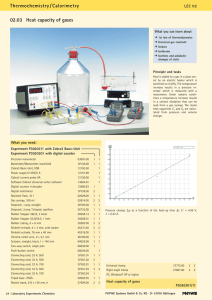Document
advertisement
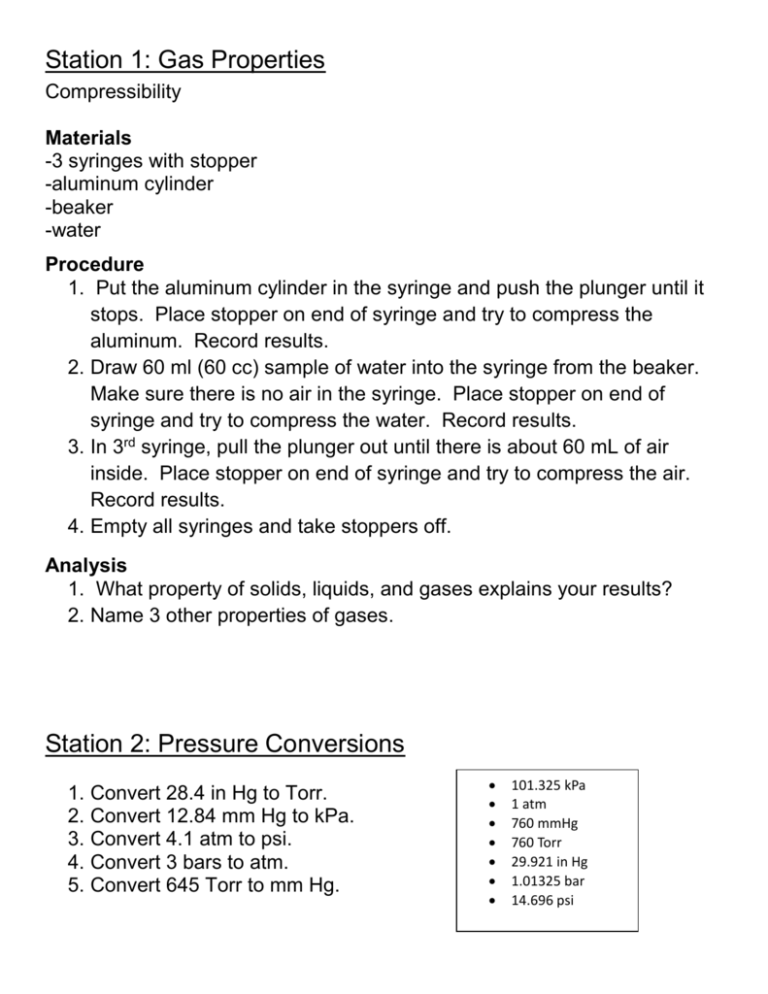
Station 1: Gas Properties Compressibility Materials -3 syringes with stopper -aluminum cylinder -beaker -water Procedure 1. Put the aluminum cylinder in the syringe and push the plunger until it stops. Place stopper on end of syringe and try to compress the aluminum. Record results. 2. Draw 60 ml (60 cc) sample of water into the syringe from the beaker. Make sure there is no air in the syringe. Place stopper on end of syringe and try to compress the water. Record results. 3. In 3rd syringe, pull the plunger out until there is about 60 mL of air inside. Place stopper on end of syringe and try to compress the air. Record results. 4. Empty all syringes and take stoppers off. Analysis 1. What property of solids, liquids, and gases explains your results? 2. Name 3 other properties of gases. Station 2: Pressure Conversions 1. Convert 28.4 in Hg to Torr. 2. Convert 12.84 mm Hg to kPa. 3. Convert 4.1 atm to psi. 4. Convert 3 bars to atm. 5. Convert 645 Torr to mm Hg. 101.325 kPa 1 atm 760 mmHg 760 Torr 29.921 in Hg 1.01325 bar 14.696 psi Station 3: Manometer Materials -manometer shape taped to lab station -pipe cleaner -ruler Closed-ended Manometer Procedure 1. Use the pipe cleaner to represent the mercury in the manometer when the flask is empty. Draw the manometer. 2. Use the pipe cleaner to represent the mercury level in a manometer with gas in the flask. Use the ruler to determine the pressure of the gas. Draw and record your measurements. Analysis 1. Is it possible for the mercury level to be higher in the arm closer to the flask? Why or why not? Open-ended Manometer Procedure 1. Use the pipe cleaner to represent the mercury level in a manometer with gas in the flask with a pressure greater than atmospheric pressure. Use the ruler to determine the pressure of the gas assuming that atmospheric pressure is 760 mm Hg. Draw and record your measurements. 2. Use the pipe cleaner to represent the mercury level in a manometer with gas in the flask with a pressure lower than atmospheric pressure. Use the ruler to determine the pressure of the gas assuming that atmospheric pressure is 760 mm Hg. Draw and record your measurements. Analysis 1. What would it mean if the mercury was level in the arms? Station 4: Partial Pressures Materials -Partial Pressure Pie Pieces Procedure 1. Choose and build a partial pressure pie so that there is a space left in the pie. Make sure all of the pie pieces are on the side listing the %. 2. Find and record the % and pressure of the missing gas piece if the total pressure is 760 mm Hg. 3. Flip all of the pieces to the pressure side. Find and record the pressure of the missing gas piece if the total pressure is 760 mm Hg. Station 5: Collection of Gas Over Water Materials -Collection Over Water Pie Procedure 1. Find and record the pressure of the dry gas if the total pressure is 1.25 atm. Station 6: Relationship of Variables Pressure and Volume Materials -one small balloon in a syringe. Procedure 1. Move the plunger so it is about at 60 mL mark. 2. Place stopper on end of syringe. 3. Push plunger in and observe. 4. Slowly remove stopper from end of syringe while watching the balloon. 5. Repeat a few times. 6. Now, compress the plunger as far as possible without squishing the balloon. 7. Place stopper on end of syringe and pull back on the plunger while watching the balloon. 8. Repeat steps 6 and 7. Analysis 1. What happens to the balloon when you compress the plunger? Why? 2. What happens to the balloon when you pull out the plunger? Why? 3. What is the mathematical relationship between pressure and volume? Station 7: Relationship of Variables Volume and Temperature Materials -one marshmallow per person -one paper plate per group -one microwave oven Procedure 1. Place one marshmallow on the plate. 2. Place plate in microwave oven and shut door. 3. Cook marshmallow for 20 seconds. 4. Watch as it cooks. 5. Once the oven is done, immediately open the door and observe. 6. Record results. 7. After 10 seconds of cooling, you may eat the marshmallow. 8. If you don’t want to eat it, place it in the trash. Analysis 1. Marshmallows are made by injecting air into a sugar solution to make a foam. Based on that, explain your observations. 2. What is the mathematical relationship between volume and temperature? 3. What is the mathematical relationship between pressure and temperature? Station 8: Relationship of Variables Materials -computer at http://phet.colorado.edu/en/simulation/gas-properties Procedure 1. If the chamber is not empty, hit the reset button. 2. Explore the relationship between variables. a. More gas can be added by using the pump. b. Gas can be let out by moving the lid at the top of the chamber. c. Heat can be added or removed at the bottom. d. The volume of the chamber can be changed by dragging the side in or out. 3. Variables can be kept constant by clicking on the corresponding button. When using these, wait for conditions to be restored after making a change. Analysis 1. What happens to the pressure as more gas is added to the chamber? Why? 2. What happens to the pressure as the temperature is increased? Why? 3. What happens to the volume as the temperature is increased if pressure is kept constant? 4. What happens to the pressure if volume is decreased when the temperature is constant? Why? 5. How is pressure created? Station 9: Ideal Gas Law 1. What is the temperature of 8.25 g of fluorine gas that occupies 30.6 L at a pressure of 1.4 atm? 2. What is the molar mass of an unknown gas if 53 g has a volume of 10.5 L at STP? 3. At what pressure would 3 moles of a gas at 25 °C take up 29 L? Analysis 1. What is STP? 2. What is the volume of 1 mole of gas at STP? 3. Can variables be removed from this law? Why or why not? Station 10: Gas Density 1. What is the density of chlorine gas at STP? 2. If the density of a gas is 1.63 g/L, what mass would occupy 17.2 L? 3. What is the molar mass of a gas with a density of 1.9 g/L if the gas is at 745 mm Hg and 20 °C? Analysis 1. Why are gas densities so much lower than densities of solids and liquids? Station 11: Combined Gas Law 1. A 3.10 mL bubble of methane gas forms at the bottom of a bog where the temperature is 12 °C and the pressure is 8.5 atm. The bubble rises to the surface where the temperature is 35 °C and the pressure is 1.18 atm. What is the new volume of the methane bubble? 2. How much pressure would you need to exert on a sample of helium at 150 kPa to compress it from 420.ml to 100. mL at constant temperature? 3. A sample of hydrogen gas at STP has a volume of 3.5 x 103 L. What will be the new volume of this gas when the temperature drops to -70 °C while the pressure remains constant? Analysis 1. What is the difference between the ideal gas law and the combined gas law? Station 12: Diffusion and Effusion 1. A gas that effuses 1.19 times slower than nitrogen is added to light bulbs. What is the molecular mass of this unknown gas? 2. A sample of O2 gas effused through a pinhole in 5.0 sec. How much time will it take for the same amount of H2 gas to effuse under the same conditions? 3. A sample of O2 gas was found to effuse at a rate equal to two times that of an unknown gas. What is the molecular weight of the unknown gas? Analysis 1. Which of the following gases will effuse the fastest: CO2, N2, Cl2, CH4, O2? Station 13: Mixed Problems 1. Find the partial pressure of a sample of oxygen collected over water when the temperature is 10.0 °C. The total pressure is 750.mmHg. The vapor pressure of water is 9.209 mmHg at 10.0 °C. 2. What is the molecular weight of a gas that has a density of 3.74 g/L at STP? 3. What is the molecular mass of a 0.2500 g sample of a gas at 99.8 °C and 0.9131 atm in a 100.0 cm3 container? Station 14: Mixed Problems 1. A 0.456 g sample of a carbon dioxide gas occupies 160. mL at 22 °C. What is the pressure in Torr that this ideal gas is under? 2. A gas is under 680. mm Hg of pressure at a temperature of 39 °C in a steel container. What is the new temperature in Kelvin when the pressure drops to 620. Torr in the same container? 3. What is the density of a NO2 (g) that is under 1.20 atm of pressure and 29.0 °C of temperature?
